Squirrel Behavior: More Than Just Nutty Antics!
Squirrels may seem like cute, bushy-tailed critters, but there’s more to them than meets the eye. Their daily routines and social lives are full of surprises. Let’s unravel the mysteries of squirrel behavior.

What is Squirrel Behavior?
At first glance, squirrels may seem like cute, bushy-tailed rodents. But their behavior reveals remarkable talents for survival, communication, and adaptation. Let’s explore what makes these common backyard critters so captivating.
Understanding the Behavior of Squirrels
Nimble Navigators
Squirrels spend much of their time leaping acrobatically among trees. With sharp claws, flexible ankles, and fluffy tails for balance, they can climb and jump with ease. This agility helps them evade predators and find food. Watching them navigate the treetops is impressive!
Chatterboxes
Squirrels have an intricate language of tail flicks, foot stomps, and chirping. These signals help them warn of danger, defend territories, and attract mates. Their communication methods are diverse and fascinating to observe.
Architects of Cozy Nests
Squirrels are skilled home builders. Using twigs, leaves, moss and even their own fur, they construct nests called dreys. These spherical dens, built high up in trees, give shelter from weather and camouflage from predators.
Foraging for Treats
With excellent senses of smell and memory, squirrels sniff out food like nuts, fruits, fungi and seeds. They bury some in caches to unearth later. Their constant foraging fuels their energetic nature.
Survival Adaptations
Squirrels have important survival skills, including speedy evasive maneuvers, distraction with their tails, and quick retreats up trees or into burrows. These tactics help them thrive despite many predators.
Urbanites
Surprisingly adaptable, many squirrels thrive living near humans. Urban squirrels grow accustomed to scavenging leftovers and nesting in man-made structures. They provide a fun dose of nature in the city.
The behavior of common squirrels reveals impressive intelligence and adaptation. Watching these energetic creatures in parks and backyards opens up their quirky world. Their antics tell a remarkable story of survival.
Why Do Squirrels Have Bushy Tails?
A squirrel’s bushy tail is more than just a fashion statement – it allows them to communicate! Squirrels use a variety of tail gestures and positions to convey different messages.

Decoding Squirrel Tail Signals
Their behavioral patterns can tell us a lot if we just watch and decode the meaning.
- Flicking – A quick tail flicking often signals danger or warns other squirrels of potential threats nearby. It tells others to be on high alert.
- Wagging – Slow, exaggerated tail wagging frequently indicates mating readiness in squirrels. It shows a female is in estrus or signals a male’s interest in breeding.
- Twitching – Subtle, sporadic tail twitching can occur when squirrels feel agitated or anxious. It’s an indicator of their emotional state.
- Raised – Keeping the tail parallel to the ground or raised upright expresses confidence and conveys dominance. It’s a sign of territorial authority.
- Puffed – Puffing up its tail makes a squirrel look bigger and shows aggression towards intruders. They may be defending a food source or nest site.
- Waving – A squirrel waving its tail gently from side to side often tries to draw attention to itself. It may indicate a desire to play or interact.
- Drooping – A tail held low against the body signals caution, submission, or fear. It usually means they feel threatened. Squirrel tail communication is complex and fascinating. Next time you spot one, observe how they use this effective tool to signal messages and moods.
Subscribe to the Free VIP Squirrel Scoop Insider Magazine
Written by none other than Bart the Balcony Squirrel, this lighthearted take on life and current squirrel-related world events is sure to bring a smile to your face. From his perch on the Kitty City Squirrels balcony, Bart brings a unique and entertaining perspective to every issue. Why wait, Subscribe now!

How Squirrels Survive and Thrive
Squirrels rely on some crafty survival skills to stay safe from predators and the elements. From dodging hawks to building cozy nests, their behaviors give them a key advantage.
Masters of Escape
When squirrels sense nearby predators like hawks, cats or snakes, they jump into action. Blazing fast sprints, zig-zag movements and instant direction changes help them evade capture. Darting up trees or into burrows provides protection.
Decoy Tails
A squirrel’s furry tail serves another purpose beyond just looking cute – it waves and flickers to distract enemies. Predators often get transfixed on the tail, allowing the squirrel precious time to get away. Such clever adaptations help them survive.
Architects of Comfy Nests
Squirrels are true artisans when building shelters called dreys high up in trees. Using twigs, leaves, moss and even their own fur, they construct well-insulated nests. These dreys protect baby squirrels and give adults cozy refuge from weather and predators.
Squirrels persist in the face of many threats through creative survival strategies. Whether dodging coyotes or curling up in a tree hole, squirrels’ behaviors reveal their remarkable resilience. Just another reason to appreciate these spunky critters!

Do Squirrels Hibernate, and How Does This Affect Their Behavior?
When the weather turns cold, what happens to those energetic squirrels? Do they hibernate or simply become less active? The answer depends on the type of squirrel.
Tree Squirrels Slow Down
Tree squirrels like gray, red and fox squirrels don’t fully hibernate. But they do experience torpor – a light sleep state. Their metabolism and activity decreases. Tree squirrels sleep more in cozy nests but still emerge at times.
Ground Squirrels: True Hibernators
Ground squirrels, like chipmunks and prairie dogs, undergo true deep hibernation. For months, their body temperature drops dramatically and they don’t eat or drink. They remain in underground burrows in an extremely dormant state.
The After Effects
When ground squirrels emerge from hibernation, they move slowly at first. They seem tired and disoriented as they adjust back to normal life. But after a few weeks, they return to their usual energetic selves.
So while all squirrels reduce activity in winter, only ground squirrels experience true prolonged hibernation. Either way, it’s an important survival adaptation when cold weather strikes.

Diet Preferences: What do Squirrels Like to Eat Most?
To appreciate the feeding behavior of squirrels, let’s look at their diet preferences. Squirrels mainly forage with a sense of smell for nuts and seeds, but many also eat vegetables, fruits, and even small insects, bugs, and bird eggs opportunistically.
With over 200 species globally, squirrels have adapted to eat a variety of foods. Let’s explore some of their unique dietary preferences and foraging strategies.
Tree-Dwelling Acrobats
Tree squirrels like eastern grays have mastered acrobatic food gathering. Acorns, nuts, seeds, buds, berries – if it grows on trees, they’ll find and eat it. They bury nuts and seeds to unearth later.
Pinecone Specialists
Red squirrels dine primarily on pinecones. They also enjoy fruit, nuts, mushrooms and occasionally insects. Unlike other squirrels, reds store all their food in one “larder hoard”.
Ground Dwellers
Ground squirrels munch on a diverse buffet – seeds, nuts, greens, fruits, bugs, eggs, even small critters. They don’t cache food. Instead, they fatten up pre-hibernation.
Tropical Fruit Lovers
Giant tropical squirrels, like the Malabar Giant squirrel feast on sweet fruits like mangoes and coconut. Their habitat provides a bounty of flowers, nuts and eggs too. A paradise for fruit-loving squirrels!
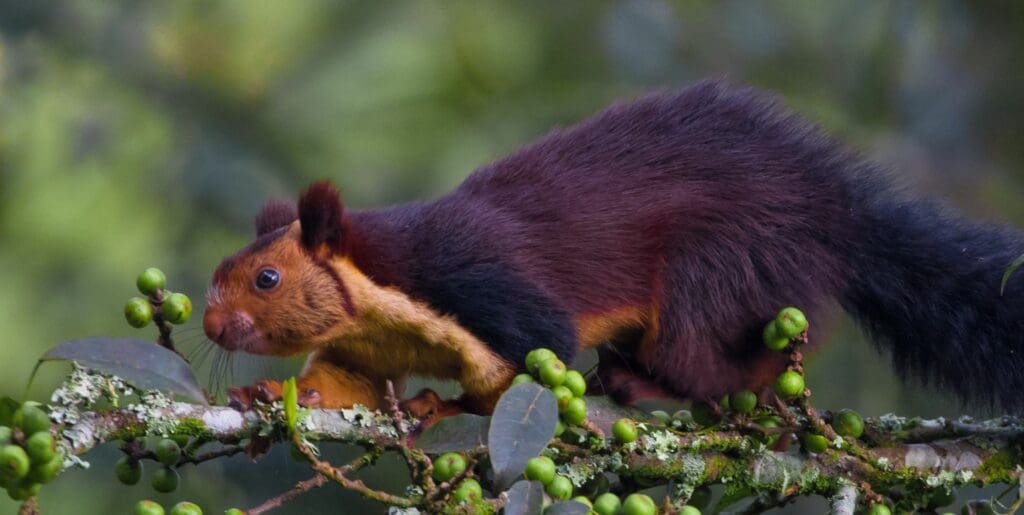
Role of Nuts in Squirrel Diet and its Impact on Squirrel Behavior
Squirrels have a diverse diet of nuts, seeds, fruits, and vegetation. Nuts critically influence squirrel behavior. The presence of valued food items like nuts and acorns can spark a flurry of activity among squirrels. Squirrels get frenzied when caching, burying nuts in various locations to retrieve them later. The availability of nuts drives squirrels to behave differently.
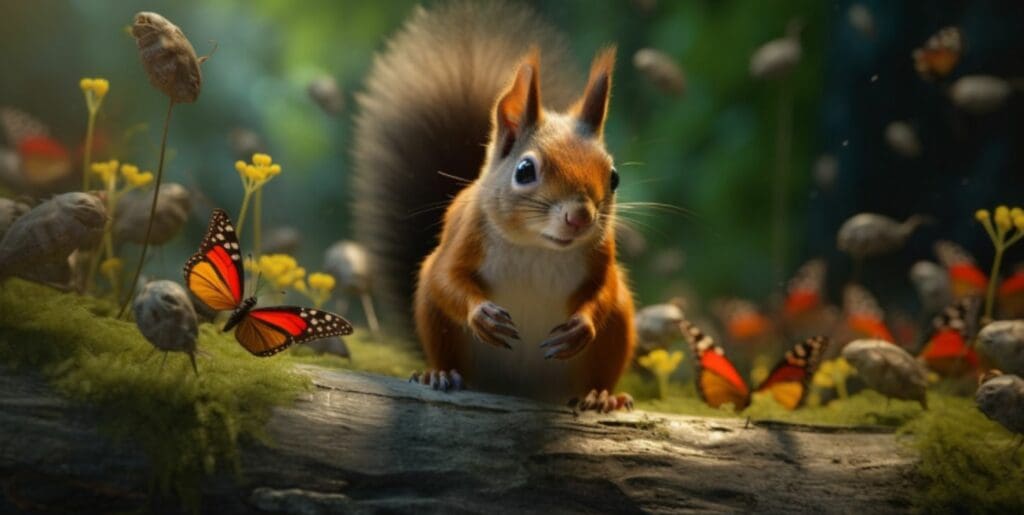
Why Do Squirrels Cache Their Food?
Squirrels practice a behavior known as food caching, where they bury food items in different locations for future consumption. This caching behavior serves as a survival strategy during times of scarcity. By spreading out their food supply, squirrels ensure they have enough to sustain themselves when resources are limited.

The Changing Behaviors of Expectant Squirrel Moms
When a female squirrel is expecting, her actions and personality begin to transform. She focuses all her energy on nurturing the babies growing inside her.
Early on, pregnant squirrels start gathering extra twigs, leaves, moss and fur to build a sturdy “nursery nest”. They also begin stashing away more food to have provisions for their future babies.
As the big day approaches, expectant moms grow calmer. They sleep more and are less interested in play. Chirping and territorial displays stop too.
Other squirrels sense the mom-to-be needs peace and quiet. They avoid dominating behaviors towards her.
After the infants are born and nursing, new squirrel moms remain very protective. But once weaned, normal activity resumes. It’s a remarkable transition back to her pre-pregnancy, energetic self!
The behavioral changes of a pregnant squirrel all ensure healthy babies. It’s a joy to observe moms-to-be preparing the next generation.

What Happens if a Squirrel is Pregnant?
- Heightened activity around nesting sites in early pregnancy.
- Increased appetite and thirst to support pregnancy.
- Food hoarding and storage for future months.
- Female squirrels eat more food due to greater nutritional needs.
- Seeking solitude from other squirrels.
- Decreased activity levels.
- Gathering materials for nest-building.
- Calm demeanor and increased sleep as delivery approaches.
- Reduction in chirping.
- Decreased playfulness, potential dominance, and territorial behavior in others.
- Return to pre-pregnancy personality after a few weeks.

Squirrel Behavior with Humans
As wilderness areas shrink, squirrels increasingly find themselves living side by side with humans. How do they adapt their behaviors in our neighborhoods and parks?
Common Patterns of Squirrel Behavior with Humans:
- Acclimation: City squirrels grow accustomed to people’s presence. They go about their daily business foraging and playing even with humans around.
- Fear and Caution: Most squirrels are wary of getting too close to humans, showing agitation and retreating when approached. But hunger may override fear, cautiously leading them to approach people for food.
- Food Seeking: Squirrels learn that humans feed them intentionally or share crumbs. This leads them to beg for snacks from park visitors frequently.
- Boldness and Aggression: Excess feeding can cause squirrels to lose their natural fear of humans. They may draw very near, even acting aggressively.
- Nest Defense: During nesting season, Squirrel moms become extra defensive of their tree nests, chasing away any perceived threat – even people.
- Adaptability: Squirrels readily inhabit urban green spaces. Some even take up residence in attics or begin digging in gardens.
Conclusion
The quirky, clever behaviors of squirrels reveal captivating details about how these spirited rodents survive and thrive. Their acrobatic leaps, chattering tail signals, and crafty food hoarding fill backyards and parks with excitement.
As squirrel enthusiasts, we cherish opportunities to observe these furry creatures in action. There’s always more to discover about their hustling and bustling lives.
To stay on top of the latest squirrel facts, photos, and stories, be sure to subscribe to our FREE “Squirrel Scoop Insider” newsletter. We deliver monthly scoops to inbox to satisfy your curiosity about all things squirrel.
Don’t miss out on the newest nuts and bolts of squirrel adventures. Sign up today so you’re among the first to get the “Squirrel Scoop Insider”!
FAQs
Q: What are some key types of squirrels?
A: Major squirrel species include red, gray, fox, flying, and ground squirrels.
Q: What do squirrels do all day?
A: Squirrels spend their time foraging, caching food, building nests, climbing trees, playing, and socializing.
Q: Where do squirrels build nests?
A: Squirrels build nests called dreys high up in trees or in tree holes using twigs, leaves, moss and fur for insulation.
Q: What do urban squirrels eat?
A: Urban squirrels adapt to scavenge human food like crumbs, leftovers, birdseed and trash.
Q: Do squirrels hibernate in winter?
A: Tree squirrels reduce activity in winter but don’t fully hibernate. Ground squirrels hibernate deeply for months.
Q: How do squirrels communicate?
A: Squirrels communicate through vocalizations like chirps and tail movements, including flicks to signal danger and wagging to show mating interest.
Q: Why are squirrel tails so bushy?
A: Their fluffy tails help squirrels balance as they leap between trees. Tails also serve as distraction for predators.
Q: How do squirrels evade predators?
A: Squirrels escape using speed, erratic movements, retreating up trees, and burrowing into ground. Some may puff up tails to appear bigger.
Q: What does it mean if a squirrel visits you?
A: Some believe squirrel visits symbolize resourcefulness, preparation, and balance.
Q: How can people safely observe squirrels?
A: Watch squirrels from a distance. Do not feed or interact closely with wild squirrels.
Q: How can squirrels and humans coexist?
A: Peaceful coexistence involves respecting squirrels’ space and not interfering with their natural behaviors.
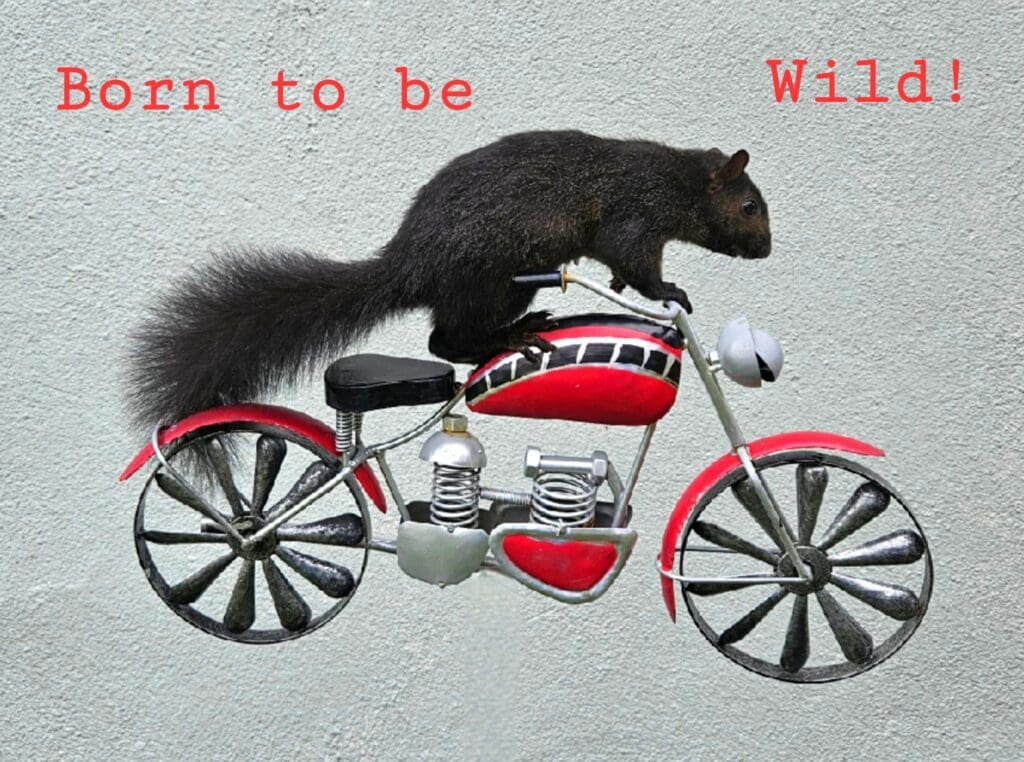
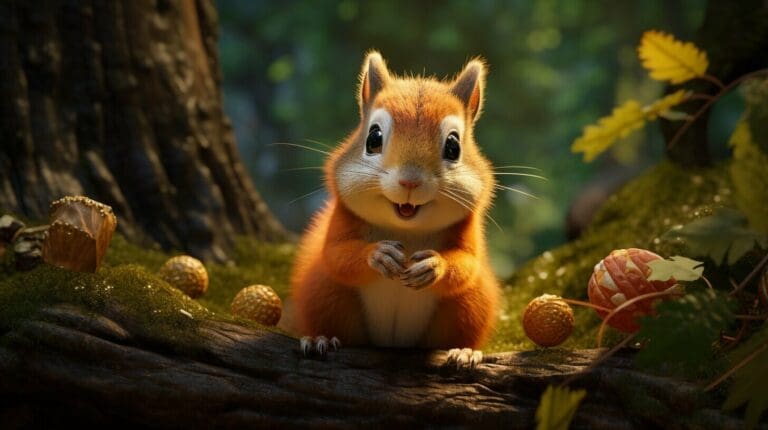
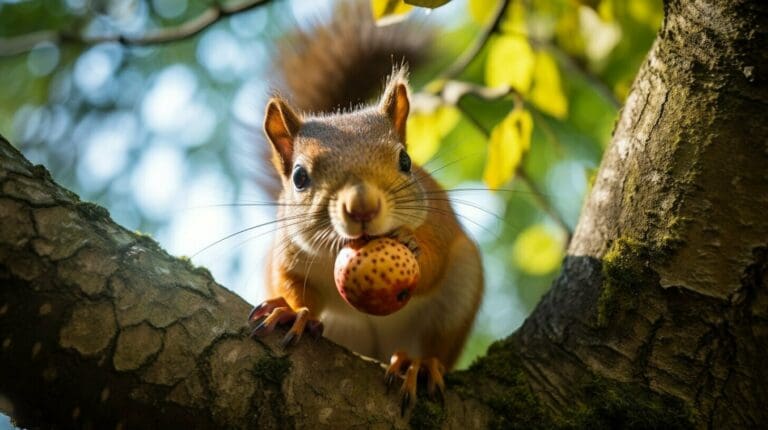
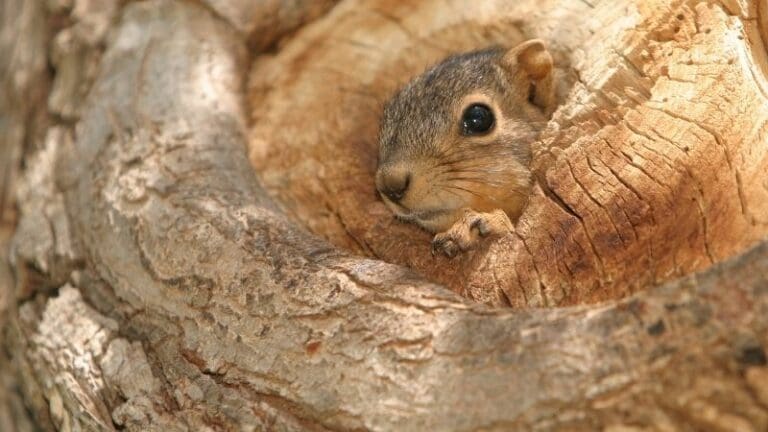
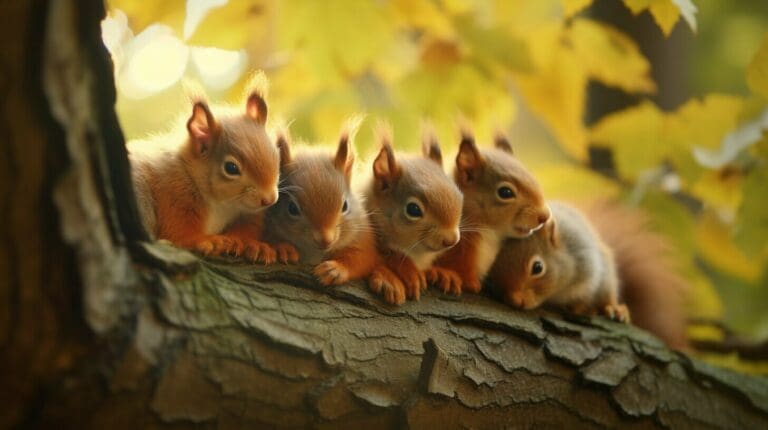

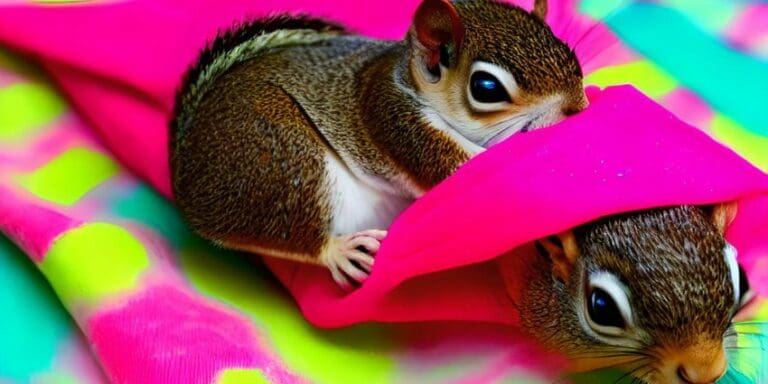
Eli and I heard some warning cherps on our yard walk tonight.
Eli and I hear some warning cherps tonight. . .we wandered to close to their tree.
They surely aren’t afraid to let you know you’ve stepped into the wrong neighborhood. Ahh, Eli is a good kitty for walking on his leash.
Maddy
Nice reporting, Bart! I need to learn tail signals now.
You need squirrel school! haha.
Thank you for letting us know you enjoyed the article. We’ll keep them coming!
We appreciate your support of the website.
Maddy
The squirrels at my sister’s house in Bolingbrook, IL, have been stealing the hand brush she used to clean her bird bath. They’ve lost about four brushes this way. My sister has been there over ten years and this is the first time the squirrels have displayed this behavior.
Can you help us understand what’s going on? What are the squirrels doing with the brushes?
Any insight will be appreciated.
Hi Laura,
Sounds like it is time to hide those brushes! All kidding aside….
Squirrels are known for their inquisitive and opportunistic nature, often leading them to interact with objects in their environment in unexpected ways. The behavior described in the request, where squirrels are taking hand brushes used for cleaning a bird bath, is not typical squirrel behavior that is widely documented, but it is not entirely surprising given their characteristics.
There could be several reasons for this behavior:
Nesting Material: Squirrels collect various materials for building and lining their nests, known as dreys. The bristles of a hand brush may seem like excellent nesting material to them, especially if they are soft or if the brushes have been used and carry the scent of oils or other residues that might be appealing to a squirrel.
Play and Teething: Squirrels, particularly young ones, are playful and explore their environment with their mouths. They also teethe and therefore might chew on various objects to help deal with the discomfort of growing new teeth.
Curiosity and Novelty: The brushes might be a novel object in their environment, and squirrels are naturally curious. They might simply be intrigued by the new item and take it to investigate.
Food Residue: If the brushes have been used to clean bird baths where birds are also fed, there might be traces of bird food, or the scent of it, on the brushes that attract the squirrels.
Territorial Behavior: Squirrels can be territorial, and moving or hiding objects might be part of their way of marking territory.
Understanding that this is a unique situation, if your sister is interested in deterring this behavior, she could try securing the brushes when not in use or providing alternative materials for the squirrels to interact with, which might reduce the allure of the brushes. She could also set up a motion-activated camera to record the squirrels’ behavior for further insight. It’s also possible to reach out to a university’s biology department for more specialized insights into this behavior.
Maddy!